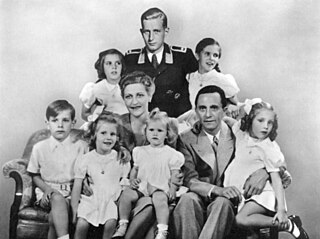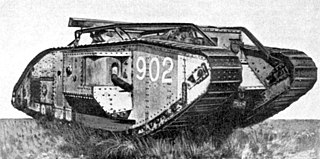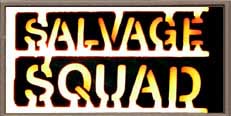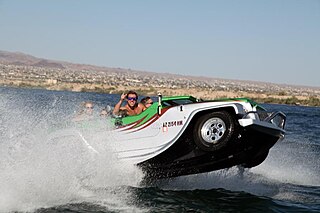
The Volkswagen Schwimmwagen is a light four-wheel drive amphibious car, used extensively by German ground forces during the Second World War. With over 15,000 units built, the Schwimmwagen is the most-produced amphibious car in history.

An amphibious vehicle is a vehicle that is a means of transport viable on land as well as on or under water. Amphibious vehicles include amphibious bicycles, ATVs, cars, buses, trucks, railway vehicles, combat vehicles and hovercraft.
Hubert Lagardelle was a pioneer of French revolutionary syndicalism. He regularly authored reviews for the Plans magazine, was co-founder of the journal Prélude, and Minister of Labour in the Vichy regime.

The Amphicar Model 770 is an amphibious automobile which was launched at the 1961 New York Auto Show. It was made in West Germany and marketed from 1961 to 1968, with production ceasing in 1965.
Clément-Bayard, Bayard-Clément, was a French manufacturer of automobiles, aeroplanes and airships founded in 1903 by entrepreneur Gustave Adolphe Clément. Clément obtained consent from the Conseil d'Etat to change his name to that of his business in 1909. The extra name celebrated the Chevalier Pierre Terrail, seigneur de Bayard who saved the town of Mézières in 1521. A statue of the Chevalier stood in front of Clément's Mézières factory, and the image was incorporated into the company logo.

Groß-Umstadt is a town in the district of Darmstadt-Dieburg in the Bundesland of Hesse in Germany. It is near Darmstadt and Frankfurt, in the southeastern part of the Rhine-Main Metropolitan Region, just north of the Odenwald mountain range.

The Gibbs Aquada is a high speed amphibious vehicle developed by Gibbs Sports Amphibians. It is capable of speeds over 160 kilometres per hour (99 mph) on land and 50 kilometres per hour on water. Rather than adding wheels to a boat design, or creating a car that floats, the Aquada was designed from the ground up to perform very well in both fields, with over 60 patents covering technical innovations.

Harald Quandt was a German industrialist, the son of industrialist Günther Quandt and Magda Behrend Rietschel. His parents divorced and his mother was later married to Joseph Goebbels. After World War II, Quandt and his older half-brother Herbert Quandt ran the industrial empire left to them by their father and which continues today, the family owning a stake in Germany's luxury car manufacturer BMW.

The development of tanks in World War I was a response to the stalemate that developed on the Western Front. Although vehicles that incorporated the basic principles of the tank had been projected in the decade or so before the War, it was the alarmingly heavy casualties of the start of its trench warfare that stimulated development. Research took place in both Great Britain and France, with Germany only belatedly following the Allies' lead.
Gyaku Jūji-jime (逆十字絞), or gyakujujijime, is a chokehold in judo. It is one of the twelve constriction techniques of Kodokan Judo in the Shime-waza list. Danzan Ryu includes this technique in the Shimete list under the name Namijujijime. Ura-Juji-Jime is described in the Canon Of Judo and demonstrated in The Essence of Judo by Kyuzo Mifune.

Salvage Squad is a British television programme, in which the "Salvage Squad" faced the challenge of restoring an item of classic machinery. The task was usually against a tight deadline, such as a public unveiling at a vehicle rally. In addition to vintage cars, lorries, railway engines, boats and aircraft, the challenges included the resurrection of a Hampshire water mill and a set of fairground gallopers.

A car, or an automobile, is a motor vehicle with wheels. Most definitions of cars say that they run primarily on roads, seat one to eight people, have four wheels, and mainly transport people, not cargo.

Marathon was a French automobile manufacturer established by a group of engineers under the leadership of a rally enthusiast called Bernard Denis. Prototypes for a lightweight sports coupé were presented at various motor shows starting with the 1951 Frankfurt Motor Show and the cars were produced between 1953 and 1955.

An amphibious automobile is an automobile that is a means of transport viable on land as well as on or under water. They are unarmored for civilian use.

WaterCar is an American company that specializes in the manufacture and development of luxury amphibious vehicles. Based in Southern California, the company was founded by Dave March in 1999 when he was inspired by the Amphicar of the 1960s. March claims he originally had no plans to market an amphibious vehicle — just merely to build one. In 2013, the company released its first commercial vehicle, the Panther, which holds a top speed of 80 mph (130 km/h) on land and 45 mph (72 km/h) on water. The company holds 27 amphibious related patents as well as the Guinness World Record for the fastest amphibious vehicle. WaterCar vehicles are designed and manufactured at Fountain Valley BodyWorks, an 85,000 square feet (7,900 m2) collision repair auto body shop in Southern California, owned and operated by March.

The Trippel SG 6 was a Schwimmwagen developed in the 1930s and used by the German ground forces during the Second World War.

Ronald Ray Hackenberger is an American businessman and car collector. He started as a truck driver before running his own trucking business, before moving into ranching, real estate, and hospitality. He bought his first Studebaker at 15, and had a collection of over 700 vehicles, including over 250 Studebakers, which were all sold at auction in July 2017.

Eduard Trippel is a German judoka. He won the silver medal in the men's 90 kg event at the 2020 Summer Olympics in Tokyo, Japan. He also won one of the bronze medals in the mixed team event. He competed at the World Judo Championships in 2018, 2019 and 2021.

KFZ.1 Kubelwagen: Volkswagen Type 82 is a reference work published by Almark Publication in 1978 about a military vehicle used by German forces during World War II.














